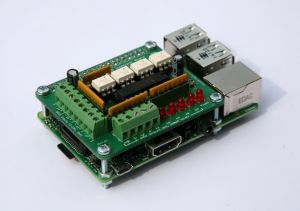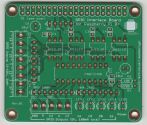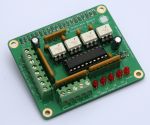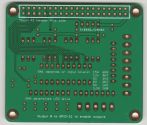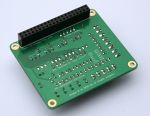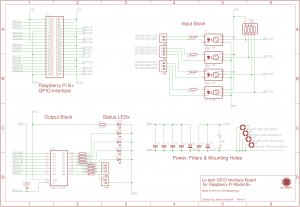Lo-tech GPIO Interface Board
The Lo-tech GPIO Interface Board enables the connection of the RaspberryPi Model B+ to the outside world, with 4 inputs and 8 outputs. The board has been designed to fit directly on top of the RaspberryPi Model B+ and features low power consumption, being powered directly from the RaspberryPi.
Specifications
- Small form-factor:
- Mounts directly to RaspberryPi device and fits within device footprint (65x56mm)
- 2.8mm mounting holes aligned with RaspberryPi device mounting holes
- 11mm spacing between boards (use 11mm standoff)
- Powered entirely from GPIO header - no separate power connection required
- Inputs:
- Four independent opto-isolated inputs with screw terminals
- Recommended input levels: 3.3V to 15V
- Outputs:
- Four 5V TTL outputs with screw terminals
- Four on-board LEDs (2-pin headers can be mounted in place of LEDs, if required)
- Single control GPIO control to enable/disable all outputs
- Total assembled weight: 34g (about 85g including RaspberryPi B+ and screws)
Note: this board does not provide the auto-configuration capabilities defined in the RaspberryPi HAT specification; GPIOs must be manually configured during program initialisation. Pull-ups are provided where necessary to prevent spurious output values.
Inputs
Note: GPIO numbering follows the BCM numbering
The board provides four inputs (GPIOs 22, 23, 24, and 27), each interfaced through an H11L1M opto-isolator. The inputs require 2mA drive, which should be set via appropriate value of RN1. It is therefore possible to use inputs from almost any low-voltage source (note: never connect mains voltage to this board).
| Input Logic Level | RN1 Value |
|---|---|
| 15V | 6K8 |
| 12V | 4K7 |
| 9V | 3K3 |
| 6V | 2K2 |
| 5V | 1K5 |
| 3.3V | 1K |
RN1 is Bourns 4608X-102 type (isolated, 8-pin 4-element)
Outputs
Note: GPIO numbering follows the BCM numbering
The board outputs are driven by a 74ACT245N Octal Bus Transceiver. The transceiver gate is controlled by GPIO 21; initialisation process for outputs is:
- Set GPIOs 5, 6, 12, 13, 16, 19. 20, 21, 26 to output mode
- Output value 0 (or 1, as required) to the output channels 5, 6, 12, 13, 16, 19, 20, 26
- Output value 0 to GPIO 21 to enable the bus transceiver
The eight 5V TTL outputs divided into:
- four outputs via screw terminals, for connection to external devices - GPIOs 5, 6, 12, 13
- four outputs to on-board LEDs - GPIOs 16, 19, 20, 26
The total draw across all outputs should not exceed 180mA, and note that power for the outputs is sourced from the RaspberryPi 5V rail.
- Choose RN3 value to match required output impedance (i.e. 100-Ohm)
- Choose RN4 value to provide appropriate current through attached LEDs
- Ensure total current draw will not exceed 180mA
- RN3 and RN4 are Bourns 4608X-102 type (isolated, 8-pin 4-element)
Bill of Materials
| Part | Value | Device | Package | Qty | Farnell | Mouser |
|---|---|---|---|---|---|---|
| C1..C5 | 0.1uF (100nF) | Ceramic Capacitor | THT | 4 | 2112751 | 594-K104K15X7RF5UH5 |
| C6, C7 | 10uF | Electrolytic Capacitor | E2-5 | 2 | 8767084 | 647-UVR1C100MDD |
| HD1, HD2, HD5 (Farnell parts) | 1x2 Screw Terminal | MULTICOMP MC000045 | THT | 3 | 2008016 | - |
| HD3, HD4 (Farnell parts) | 1x2 Screw Terminal | MULTICOMP MC000044 | THT | 2 | 2008015 | - |
| HD1, HD2, HD3 (Mouser parts) | 8-way screw terminal (3.81mm) | FCI 20020327-D081B01LF | THT | 1 | - | 649-220327-D081B01LF |
| HD4, HD5 (Mouser parts) | 5-way screw terminal (3.81mm) | 20020327-D051B01LF | THT | 1 | - | 649-220327-D051B01LF |
| IC1..IC4 | - | H11L1M Optocoupler, Schmitt Trigger | DIP-6 | 4 | 1021127 | 512-H11L1M |
| IC5 | - | 74ACT245N Octal Bus Transceiver | DIP-20 | 1 | 1739622 | 595-SN74ACT245N |
| LED1..LED5 | - | 3mm LED | THT | 5 | 1581112 | 645-521-9432F (red) 859-LTL-2231AT (green) |
| P1 | - | SOCKET, PCB, 0.1", 20+20WAY | THT | 1 | 7992033 | 855-M20-7832046 |
| R1 | 270R | 125mW Carbon Film Resistor | THT | 1 | 2329504 | 299-270-RC |
| R2 | 10k | 125mW Carbon Film Resistor | THT | 1 | 9342419 | 299-10K-RC |
| RN1, RN3, RN4 | See table* | SIL-8 Resistor Network (Bournes 4608X-102 type) | THT | 3 | See table* | See table* |
| RN2 | 10k | Bournes 4605X-101-103LF | THT | 1 | 9356061 | 652-4605X-1LF-10K |
| DIL Socket, 8-pin | - | SOCKET, VERTICAL, 1ROW, 8WAY | THT | 1* | 3419101 | 571-215297-8 |
| IC Socket (DIP20) | - | - | DIL20 | 1 | 1101349 | 571-1-2199298-6 |
| IC Socket (DIP6) | - | - | DIL6 | 4 | 1077343 | 571-1-2199298-1 |
*For values of RN1, RN3 and RN4, see tables in Inputs and Outputs sections. Three components are needed for each board, with values chosen to match the desired input voltage levels and output drive current. These components can be changed after construction if SIL-8 sockets are mounted to the board (one socket is specified in the above component list for RN1, since this value is most likely to be changed to interface to different input voltage levels). Component options are:
| Value | Part | Farnell | Mouser |
|---|---|---|---|
| 100R | 4608X-102-101LF | 9356509 | 652-4608X-2LF-100 |
| 270R | 4608X-102-271LF | 9356622 | 652-4608X-2LF-270 |
| 1k | 4608X-102-102LF | 9356517 | 652-4608X-2LF-1K |
| 1k5 | 4608X-102-152LF | 9356568 | 652-4608X-2LF-1.5K |
| 2k2 | 4608X-102-222LF | 9356592 | 652-4608X-2LF-2.2K |
| 3k3 | 4608X-102-332LF | 9356673 | 652-4608X-2LF-3.3K |
| 4k7 | 4608X-102-472LF | 9356703 | 652-4608X-2LF-4.7K |
| 6k8 | 4608X-102-682LF | 2321777 | 652-4608X-2LF-6.8K |
Schematic
Use of this design is provided subject to the lo-tech.co.uk Terms and Conditions. Copyright (c) 2014 Peacon Ltd.
Programming
Any library suitable for use with the Raspberry Pi Model B+ can be used, for example WiringPi. The GPIO channels used are:
| BCM GPIO | Purpose | Notes |
|---|---|---|
| 5 | Output (5V TTL) | Screw terminal output |
| 6 | Output (5V TTL) | Screw terminal output |
| 12 | Output (5V TTL) | Screw terminal output |
| 13 | Output (5V TTL) | Screw terminal output |
| 16 | Output | Onboard LED |
| 19 | Output | Onboard LED |
| 20 | Output | Onboard LED |
| 21 | Output Control | Output 0 to enable all other outputs; Output 1 to set high-Z state |
| 22 | Input | See note |
| 23 | Input | See note |
| 24 | Input | See note |
| 26 | Output | Onboard LED |
| 27 | Input | See note |
Note: The specified H11L1M opto-isolator has an LED forward voltage of 1.2V and requires 2mA drive.
